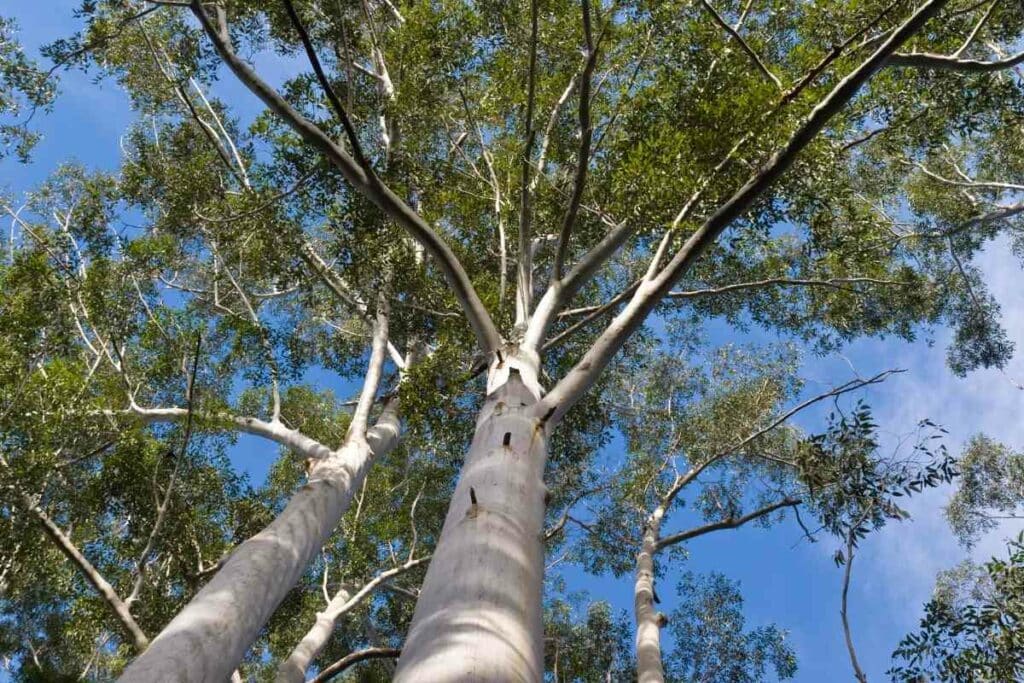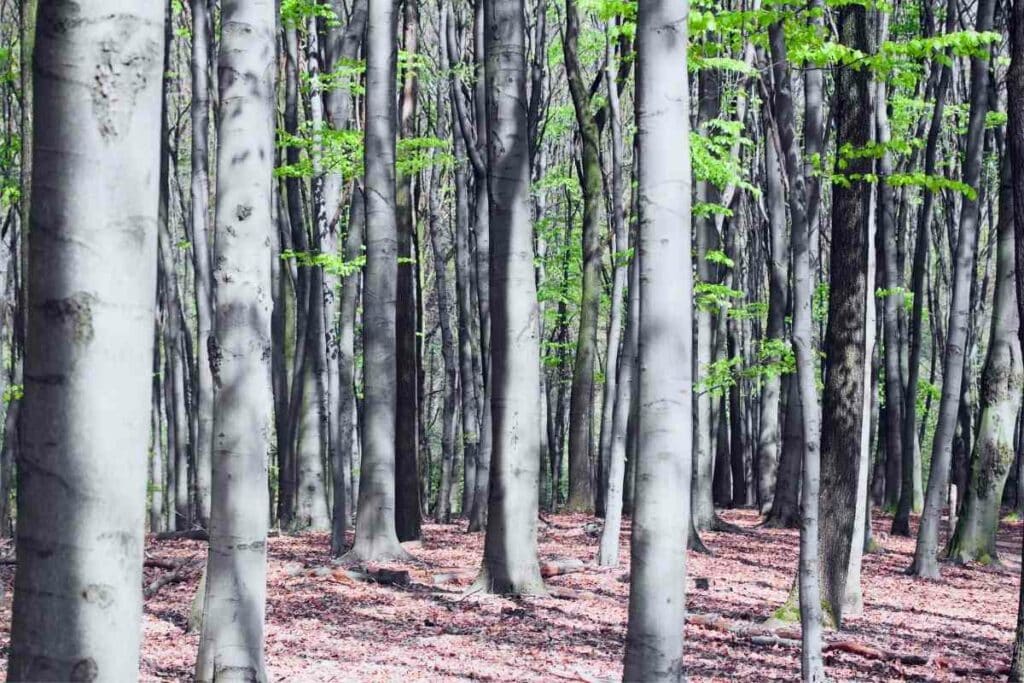The bark of a tree is one of its most essential features. It protects the tree from animal and weather damage and helps provide nutrients to growing cells within the trunk.
But not all bark is created equal: Some trees have thin, smooth bark while others have thick, craggy bark that can be difficult for predators to get through.
Many trees have smooth bark, including birch and beech trees (which are also one of the best trees to hang a swing from), but they are not the only ones.
1. Desert Ironwood Trees
This tree’s trademark quality is that its bark is shiny, smooth, and has a distinct gray color.
The bark of this tree has been known to develop into fissures along its lifespan. However, the tree takes an incredibly long time to develop fully, so the bark will be smooth for most of its life.
The wood of the ironwood tree is dense are hard, hence the “ironwood” name. They grow in dry and hot climates (like deserts), and while the bark is a pale grey, this actually helps them to stand out against many other trees.

Older Desert Ironwood trees have fissures in their bark because they naturally crack as the tree grows—and ironwood trees can live for up to 1600 years.
The bark on the outside tends to be dead and, as a result, develops fissures over time—however, this is due to other factors, too, not just the tree’s natural growth.
Take a Closer Look – Looking at its bark color, you can easily tell if an Ironwood tree is old. Older trees display bark with a brownish tint along with the standard gray.
2. Eucalyptus Trees
The Eucalyptus tree is an incredibly varied tree species.
While most develop a smooth bark, their texture and color differ significantly from other trees in the same category.
Unlike Other Trees – Members of the Eucalyptus family typically do not have fissures. This is because the trees shed their old dried bark in favor of a new, smoother coat of bark.
This phenomenon is known as exfoliating bark—a tree usually sheds its bark like this to allow for more light and transpiration, increasing its longevity.
One of the most exciting types of barks is the Eucalyptus deglupta.

It is known for being one of the few multi-colored barks in the world, and you might have heard it by its other name: the Rainbow Eucalyptus.
They have a very distinct color, with shades of green, brown, red, and lavender stretching across the length of the tree.
Eucalyptus trees are tough to correctly identify, with most of them sharing similar features but being quite different.
A better way to identify them is by their texture. The bark feels very flaky to touch.
3. Sycamore Trees
Sycamore trees start with very smooth bark when young and come in a few appealing colors.
White, brown, gray, and occasionally tan bark grows on them. However, this varies greatly depending on its locality.
Mexican sycamore trees are a bit smaller—these trees have very smooth white bark with light brown streaks.

The bark peels off a bit differently from American trees, and it tends to be in a bit of a patchwork pattern.
Sycamore trees in Arizona have gray bark that comes off in flaky patches to reveal a smooth, milky white color—making them stand out in the family of sycamore trees.
You can quickly identify sycamore trees by the shedding of their bark and their shape.
They have a unique jigsaw shape to their bark due to the mixing of all the colors, which creates a camouflage effect.
Sycamore trees are exfoliating trees and are known to shed their bark frequently.
If you see a tree shedding itself to reveal smooth, white bark, it is most likely a member of the sycamore tree family.
4. Red Maple trees
Red maple trees have a smooth texture and are very ashen in color, with some having near-silver bark.
This bark changes over the life of the tree. As the red maple tree grows, the texture changes, as well as the color. Older Red Maple trees tend to have a darker bark, with vertical cracks that develop over time.

It also loses its smooth texture with age—older trees tend to have rougher bark, likely due to the cracks.
This bark is also splintered into distinctive plate formations, making it easy to spot an older red-maple tree. The barks tend to lose their color from the bottom as they grow.
You can identify red maple trees by their smooth, furrowed, gray bark.
If you see a darker color of bark creeping through the tree from the bottom, you can be certain you are looking at a maturing red-maple tree.
5. Japanese Stewartia
Not many trees come with multi-colored bark that peels in strips of different colors.
This feature is what makes Japanese Stewartia Among the most attractive trees in the smooth bark family.
The bark of this tree can be gray, reddish brown, orange, or cinnamon.

The surface of the inner bark is smooth, and the tree makes sure it stays that way by undergoing regular exfoliation.
Due to the way it combines its various colors, this tree’s bark particularly stands out in winter landscapes.
It is easy to distinguish Stewartia trees by checking if the bark has any combination of these colors and if the parts of the tree where the outer bark has been shed reveal a smooth surface on the inside.
6. Beech Trees
The most exciting thing about beech trees and their bark is that it stays smooth even as the tree matures. That, and it has a light silver-gray color.

The bark has etchings that protrude horizontally, but some trees also have ripples that run vertically up the bark.
There are no definitive causes for the ripples, but some theories suggest that stress on the tree changes its pattern.
The bark of this tree is also particularly thin, making it very easy to identify, and you can often tell a beech tree by its silvery etched bark.
If You’re Unsure – Check along the tree for any ripples in its texture.
7. Birch Trees
Birch trees start out with smooth bark, but as they grow older, deep ridges form on their exterior resulting in a rough bark.

Birch trees are known for losing all their bark in long strips that progress horizontally and reveal colors of yellow, silver, black, or gray.
When identifying a Birch tree, it’s crucial to note that its bark is a common food for rabbits, deer, and birds.
Many mistake the teeth marks left by animals for texture—you should always look for the horizontal strips that run across Birch trees as they shed, so you are not confused by animal markings.
Their bark is a common food of rabbits, deer, and birds, so do not mistake bite marks for patterns.
Uses of Bark
The use of tree bark can be found in a variety of fields.
If identified correctly, you can reap the benefits!
Here are a few uses for smooth tree barks.
Medicinal
Birch tree bark is used for many things—it has betulinic acid that is used heavily in pharmaceuticals.
Soaked birch tree bark can be used as an arm cast as well. Betulin can be extracted to be used as a painkiller.
Sycamore tree bark has been used to make teas for treating colds, coughs, and managing tuberculosis. It also has various laxative effects.

Desert ironwood bark has been used as an emetic to help cope with vomiting.
The flowers of the tree can be used for anti-inflammatory purposes, as well as for managing hemorrhoids.
Red maple bark has been used as an analgesic and has been used in the treatment of eye cataracts. The tea that is brewed from the bark can be used to treat diarrhea.
Beech tree bark has various uses, such as:
- being an antiseptic
- a stimulant
- and a viable option for treating skin diseases
Crafting
The bark of these trees has also been used to craft various items.
Smooth bark often produces baskets, home décor items, hair clips, and other crafts of excellent quality.
For Example – Iron Wood is one of the heaviest woods in the world and is regularly used in buildings and for firewood.
Final Thoughts
Smooth bark trees can be found all over the world.
They’re incredibly versatile, and their uses are as varied as their geography.
The smooth bark tree has been used in various ways by people all over the world, and it’s still being used today.
It’s a unique tree that provides many benefits to those who know how to use it.
Now that you have a list of trees with smooth bark, the next time you’re on a hike, try spotting one yourself!
